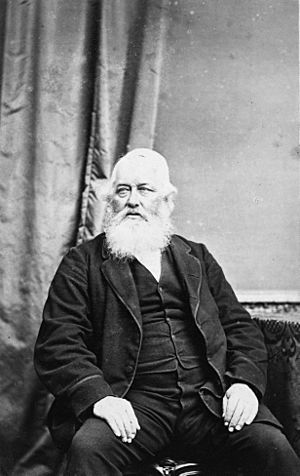John Cracroft Wilson facts for kids
Quick facts for kids
Sir John Cracroft Wilson
|
|
|---|---|
 |
|
| Member of the New Zealand Parliament for City of Christchurch |
|
| In office 1861–1866 |
|
| Preceded by | Henry Sewell |
| Succeeded by | James FitzGerald |
| Member of the New Zealand Parliament for Coleridge |
|
| In office 1866–1870 |
|
| Preceded by | new constituency |
| Succeeded by | John Karslake Karslake |
| Member of the New Zealand Parliament for Heathcote |
|
| In office 1872–1875 |
|
| Preceded by | John Hall |
| Succeeded by | James Temple Fisher |
| Personal details | |
| Born | 21 May 1808 Onamore, India |
| Died | 2 March 1881 (aged 72) Cashmere, New Zealand |
| Spouses | |
| Relations |
|
| Children | 8 (Laura, William, Emma, Frederick, Constance, Alexander, Laura, and Walter) from first marriage |
| Residence | Cracroft Wilson estate |
| Occupation |
|
Sir John Cracroft Wilson (21 May 1808 – 2 March 1881) was an important person who worked as a government official in India, then became a farmer and politician in New Zealand. He was also known as Nabob Wilson.
Contents
Early Life and Work in India
John Cracroft Wilson was born in Onamore, India, in 1808. His father, Alexander Wilson, was a judge and a botanist (someone who studies plants). His mother, Elizabeth Clementina Wilson, came from a well-known family called the Cracrofts. John was given his mother's family name, Cracroft, as a middle name. This became a family tradition.
He went to school at Haileybury College and Brasenose College, Oxford in England. In 1828, he returned to India to work for the government. He started as a cadet and later became a magistrate, which is like a judge. He helped investigate and stop dangerous groups in the Doab region.
John Cracroft Wilson married Elizabeth Wall in 1828. They had eight children together. Sadly, Elizabeth passed away in 1843. He married again in 1844 to Jane Torie Greig. They did not have any children.
Moving to Australia and New Zealand
In 1853, John Cracroft Wilson's health wasn't good, so he was advised to move to a cooler place. He wanted to find a country where people who worked for the East India Company could retire. He sailed to Australia with his wife, daughter Emma, many servants, and animals.
He didn't like Australia much. But he met Alfred Cox, who was buying sheep for his farm in New Zealand. Wilson decided to go to New Zealand too. He bought sheep and cattle in Sydney and took them to Lyttelton on a ship called the Akbar. The journey was very difficult, and many of his animals died.
He arrived in New Zealand on 8 April 1854. He lost more animals to poisonous plants and bad weather. His group traveled over the Port Hills to an area where he bought land. He named his farm Cashmere, after Kashmir in India. Today, Cashmere is a suburb of Christchurch. He also leased three other large farms. At his Cashmere farm, he built a large house and farm buildings.
In 1855, Wilson returned to India. His eldest son came to New Zealand to manage the farms. His wife and daughter Emma followed him to India later. Emma met Logan Campbell on the journey. They married in 1858 and later lived in New Zealand.
Heroic Actions in India
When Wilson arrived back in India in 1855, he played a very important role during the Indian Rebellion of 1857. He was given special powers and worked hard to prevent trouble from spreading. His actions were so effective that the Viceroy of India, Lord Canning, praised him.
Lord Canning said that Wilson had "saved more Christian lives than any man in India" by being brave and determined, even when his own life was in danger.
Because of his bravery, Queen Victoria honored him in 1860, making him a Companion of the Order of the Bath (CB). In 1872, he was made a Knight Commander of the Order of the Star of India (KCSI). This is why he is known as Sir John Cracroft Wilson.
Political Life in New Zealand
After returning to New Zealand in 1859, Sir John Cracroft Wilson became a politician. He was elected to the House of Representatives, which is like the country's parliament.
He represented three different areas:
- City of Christchurch from 1861 to 1866
- Coleridge from 1866 to 1870
- Heathcote from 1872 to 1875
He was known for being a strong and sometimes challenging speaker. When discussing Māori affairs, he often used his experiences from India to support his ideas. For example, he suggested using Gurkha soldiers, who were known for their fighting skills, to help end conflicts quickly.
Besides national politics, he was also involved in local government. He served on the Canterbury Provincial Council for several years. He was also part of the Canterbury Executive Council, which helped run the province.
Sir John Cracroft Wilson was also active in many local groups. He was a member of the Canterbury Acclimatisation Society, which introduced new animals and plants to New Zealand. He helped choose the location for the racecourse for the Canterbury Jockey Club. He also commanded the Canterbury Yeomanry Cavalry, supported opera and drama, and was a governor of Canterbury College. As a farmer, he brought special sheep to New Zealand to start a breeding flock.
Later Years and Legacy
Sir John Cracroft Wilson passed away at his home in Cashmere, Christchurch, on 2 March 1881. He was survived by his wife and four of his children.
During World War II, the military used his old estate, the Cracroft Wilson estate, as their headquarters. Secret work was done in the Cracroft Caverns underneath the house, starting in 1942.

